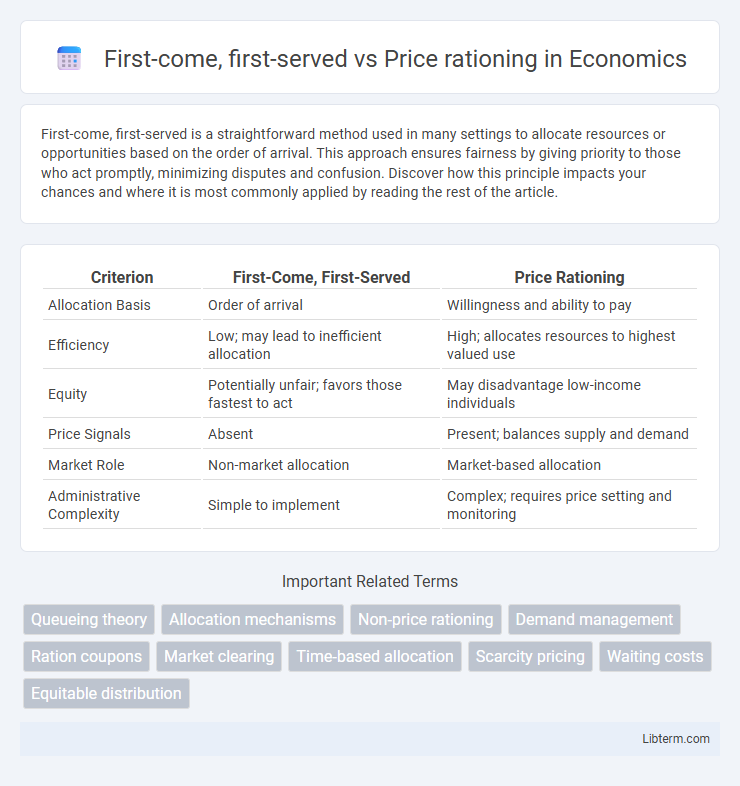First-come, first-served is a straightforward method used in many settings to allocate resources or opportunities based on the order of arrival. This approach ensures fairness by giving priority to those who act promptly, minimizing disputes and confusion. Discover how this principle impacts your chances and where it is most commonly applied by reading the rest of the article.
Table of Comparison
| Criterion | First-Come, First-Served | Price Rationing |
|---|---|---|
| Allocation Basis | Order of arrival | Willingness and ability to pay |
| Efficiency | Low; may lead to inefficient allocation | High; allocates resources to highest valued use |
| Equity | Potentially unfair; favors those fastest to act | May disadvantage low-income individuals |
| Price Signals | Absent | Present; balances supply and demand |
| Market Role | Non-market allocation | Market-based allocation |
| Administrative Complexity | Simple to implement | Complex; requires price setting and monitoring |
Introduction to Rationing Methods
Rationing methods allocate scarce resources through different mechanisms, with first-come, first-served granting access based on order of arrival, while price rationing uses market-driven signals to balance supply and demand. First-come, first-served ensures fairness by treating all participants equally regardless of willingness to pay, but may cause long queues and inefficiencies. Price rationing incentivizes efficient allocation by allowing those who value the resource most to secure it at a higher price, though it risks excluding lower-income individuals.
Defining First-Come, First-Served (FCFS)
First-Come, First-Served (FCFS) is an allocation method where resources or services are distributed to individuals in the exact order they arrive or request them, without considering price or demand elasticity. This system ensures fairness by prioritizing temporal sequence rather than willingness or ability to pay, often used in situations with limited supply but equal access. Unlike Price Rationing, FCFS does not use price signals to regulate demand, potentially leading to inefficiencies or shortages when demand exceeds supply.
Understanding Price Rationing
Price rationing allocates goods and services based on consumers' willingness and ability to pay, efficiently balancing supply and demand through price adjustments. This mechanism encourages producers to increase supply or innovate when prices rise, reflecting scarcity and consumer preferences more accurately than first-come, first-served methods. Understanding price rationing is essential for analyzing market dynamics and the allocation of limited resources in competitive environments.
Historical Context of Allocation Systems
First-come, first-served allocation system has historical roots in traditional market practices where goods and services were distributed based on order of arrival, ensuring fairness in access but often leading to inefficiencies and long queues. Price rationing emerged from economic theories emphasizing scarcity management, using price signals to allocate resources efficiently by balancing supply and demand, particularly during periods of shortages like the Great Depression and wartime economies. Both systems reflect different societal approaches to resource allocation, with first-come, first-served prioritizing equal opportunity, while price rationing focuses on economic efficiency and market equilibrium.
Efficiency of First-Come, First-Served
First-Come, First-Served (FCFS) allocation prioritizes access based on arrival time rather than willingness to pay, often leading to inefficiencies like queue congestion and wasted time. Unlike price rationing, which allocates goods to those valuing them most directly through market mechanisms, FCFS may result in resources not reaching the highest-valuing users. This inefficiency emerges because FCFS fails to use price signals to balance demand and supply optimally, potentially causing both shortages and surpluses in allocation.
Economic Impact of Price Rationing
Price rationing allocates goods based on consumers' willingness and ability to pay, leading to more efficient distribution by reflecting true market demand and promoting optimal resource allocation. This mechanism incentivizes producers to increase supply and innovate, thereby potentially boosting overall economic growth. However, price rationing can exacerbate inequality by limiting access for lower-income individuals, potentially reducing social welfare despite its efficiency gains.
Fairness and Equity Considerations
First-come, first-served allocates resources based on arrival time, often benefiting those with quicker access but potentially disadvantaging individuals lacking timely information or mobility, raising fairness concerns. Price rationing distributes goods according to willingness and ability to pay, which can lead to inequities by favoring wealthier individuals while marginalizing lower-income groups. Evaluating fairness requires balancing equitable access with efficiency, considering socioeconomic disparities and the impact on vulnerable populations.
Real-world Examples and Case Studies
First-come, first-served allocation is commonly seen in limited edition product launches, such as sneakers or concert tickets, where demand exceeds supply and consumers compete based on timing. Price rationing occurs in housing markets or airline seats, where price serves as a signal to allocate scarce resources efficiently, often balancing demand and supply dynamically. Case studies of vaccine distribution highlight the interplay of both methods, showing how initial supply shortages favored first-come, first-served allocation, while later stages adopted price or priority-based rationing to manage access and equity.
Limitations and Challenges of Each Method
First-come, first-served allocation can lead to inefficiencies such as long wait times and does not account for varying willingness to pay, resulting in potential misallocation of resources. Price rationing, while economically efficient by allocating goods to those who value them most, may exclude lower-income individuals and lead to inequity in access. Both methods face challenges in balancing fairness and efficiency, with first-come, first-served struggling under high demand and price rationing requiring accurate price signals and market conditions to function effectively.
Choosing the Optimal Rationing System
Choosing the optimal rationing system depends on balancing efficiency and fairness. First-come, first-served prioritizes timely access but can lead to resource wastage and long wait times, whereas price rationing efficiently allocates scarce goods by leveraging supply and demand dynamics but may exclude lower-income individuals. An optimal system often combines elements of both to ensure equitable distribution while maximizing resource utilization.
First-come, first-served Infographic

 libterm.com
libterm.com